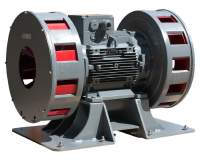Large Motorised Sirens
| Large Motorised Sirens | |

| |
| Company | Klaxon Signals Ltd. |
|---|---|
| Produced | 1940s?-present |
| Type | Omnidirectional Electromechanical |
| Sound output | 120 dB @ 100 ft/30 m |
| Frequency | 50 Hz |
Large Motorised Sirens is a Klaxon Signals product category comprised of Klaxon's well-known uni/bidirectional electric motor sirens. The General Purpose (GP) and Fireproof (FP) ranges are well established regionally and have lineage tracing back to World War II, where the first iterations of the GP sirens were used to warn the public of incoming Axis air raids. These sirens have seen multiple changes throughout the years but still maintain their status as reliable and rugged alarms suitable for almost any environment and purpose.
History
The Service Electric Company Ltd. was founded in 1930 to produce industrial fans and blowers. In the late 1930s to early 1940s, Service Electric began manufacturing air raid sirens under the brand Secomak. Secomak debuted their first product as the Secomak GP8 to moderate success. Following the design trend of the time in the UK, the GP8 was one of many dual rotor, dual tone electric sirens produced during and after the war.
After WWII, Secomak began eyeing other hazardous areas - specifically, chemical plants and refineries. Secomak began working on a solenoid operated shutter mechanism for their GP8 sirens, which was officially released in 1952 as the CS8. Secomak would also later introduce a single-tone version of the GP8 as the GP6, as they did with the CS6 not far after.
In 1989, Secomak was officially branded to Klaxon Signals Ltd., as it stands today. The design of the sirens were slightly altered with the addition of a plate over the exposed end of the rotors, which improved air pressure through the intakes. It is suspected it is around this time that the Klaxon GP12 was rolled out, and this is proven as the GP12 was confirmed on the market in early 2001. In 2006, the GP8 was taken off the market as the GP12 was deemed more effective and modernized than the GP8.
Design
General Purpose (GP)
GP6
WIP
Klaxon fitted a solenoid operated shutter mechanism (at extra cost) to the GP6 upon the buyer's request to provide additional clearly defined signals. The mechanism utilizes a hollow tube attached to the stator, a box attached to the side of the tube containing a solenoid, and a shutter controlled by the solenoid within the tube. When the shutter is lifted, air is allowed into the rotor and dispersed through the stator ports, and when the shutter is released, air is blocked from entering, and the sound from the rotor is reduced. This attachment allows the siren (named the CS6; CS standing for Coded Shutters) to perform pulsed steady and pulsed wail signals. Very few CS6 sirens remain today. The "CS" shutter mechanisms were discontinued by the end of 2008.
GP8
WIP
Klaxon fitted solenoid operated shutter mechanisms (at extra cost) to the GP8 upon the buyer's request to provide additional clearly defined signals. The mechanisms utilize hollow tube attached to each stator, boxes attached to the side of the tubes containing a solenoid, and shutters controlled by the solenoid within the tubes. When the shutters are lifted, air is allowed into the rotors and dispersed through the stator ports, and when the shutter is released, air is blocked from entering, and the sound from the rotors is reduced. This attachment allows the siren (named the CS8; CS standing for Coded Shutters) to perform pulsed steady and pulsed wail signals. A majority of CS sirens that remain today are of the CS8 variety. The "CS" shutter mechanisms were discontinued by the end of 2008.
GP10
WIP
Klaxon fitted a solenoid operated shutter mechanism (at extra cost) to the GP10 upon the buyer's request to provide additional clearly defined signals. The mechanism utilizes a hollow tube attached to the stator, a box attached to the side of the tube containing a solenoid, and a shutter controlled by the solenoid within the tube. When the shutter is lifted, air is allowed into the rotor and dispersed through the stator ports, and when the shutter is released, air is blocked from entering, and the sound from the rotor is reduced. This attachment allows the siren (named the CS10; CS standing for Coded Shutters) to perform pulsed steady and pulsed wail signals. No CS10 sirens are known to exist today. The "CS" shutter mechanisms were discontinued by the end of 2008.
GP12
WIP
Klaxon fitted solenoid operated shutter mechanisms (at extra cost) to the GP12 upon the buyer's request to provide additional clearly defined signals. The mechanisms utilize hollow tube attached to each stator, boxes attached to the side of the tubes containing a solenoid, and shutters controlled by the solenoid within the tubes. When the shutters are lifted, air is allowed into the rotors and dispersed through the stator ports, and when the shutter is released, air is blocked from entering, and the sound from the rotors is reduced. This attachment allows the siren (named the CS12; CS standing for Coded Shutters) to perform pulsed steady and pulsed wail signals. No CS12 sirens are known to exist today. The "CS" shutter mechanisms were discontinued by the end of 2008.
Fireproof (FP)
FP6
WIP
FP10
WIP